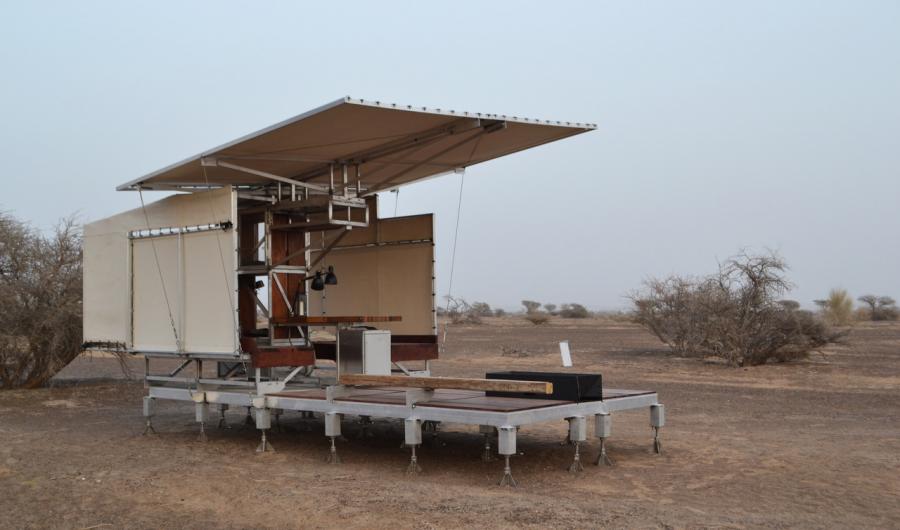- About
- Admissions
- Study at AUS
- Prospective Students
- Bachelor's Degrees
- Master's Degrees
- Doctoral Degrees
- Admission Publications
- International Students
- Contact Admissions
- Grants and Scholarships
- Sponsorship Liaison Services
- Testing Center
- New Student Guide
- File Completion
- New Student Orientation
- Payment Guide
- Executive Education
- Students with Disabilities
- Academics
- Life at AUS
- Research
- Contact Us
- Apply Now
- .

Architecture students win AIA award for desert shelter
Sharjah, UAE. December 18, 2018—Architecture students from the College of Architecture, Art and Design (CAAD) at American University of Sharjah (AUS) have received an Honorable Mention Design Award by the American Institute of Architects (AIA) Middle East Chapter for their innovative “Neonomads” desert shelter and research station.
The AIA Middle East Chapter's annual design awards program recognizes excellence in architecture, interior architecture, urban design and unbuilt projects undertaken by its members.
The Neonomads project was acclaimed by the AIA Middle East Chapter for its genuine program flexibility and function as an expanding, unconditioned shelter, which can serve as a self-powered, demountable research station in extreme desert conditions.
Initiated as part of the college’s robust architecture curriculum during the Fall Semester 2017 and Spring Semester 2018, the award-winning structure was created by a group of 34 fourth- and fifth-year architecture students who were commissioned to design and construct a lightweight, sustainable, demountable desert shelter and research station for environmental scientists of the Sharjah Environment and Protected Areas Authority.
Guided by Assistant Professors of Architecture Patrick Rhodes and Gregory Spaw, the students worked together to find an innovative solution for expeditions across the Rub’ al Khali, or Empty Quarter—an area of more than 650,000 square kilometers of continuous desert that spans the UAE, Saudi Arabia and Yemen—while addressing the fundamental challenges of the desert environment.
“For thousands of years, Bedouins are the only known people to have successfully traversed the Empty Quarter. The first foreign explorers weren't able to penetrate it until 1931, with the first Western maps made by British explorer Wilfred Thesiger between 1946 and 1950, and since then, only a few extreme adventurers have attempted its crossing, leaving the rest of us to wonder at its edge,” explained Rhodes.
“By mounting an expedition to sensitively construct and deploy a basic shelter, we hope to
allow people to get a little farther out to experience a little-known people and place. Through the Neonomads design–build studio project, we hope to inspire journey and adventure,” Rhodes said.
Over a period of six months, the students designed, prototyped, prefabricated and deployed a lightweight, basic structure programmed to provide fundamental protection from the elements, including shade, access to water, fire, light and basic communication with the outside world.
“Tracing ancient caravan routes of the frankincense trade between the UAE and southern Oman, the Neonomads structure can now act as a primary basecamp and a satellite way station, outward bound into the Empty Quarter, the first of a possible sequence of nodes of a wider network of infrastructure designed for experiencing and exploring one of the most unique and otherworldly landscapes on the planet,” said Rhodes.
Rhodes said the project gave students the opportunity to be engaged in every aspect of the architectural process, both from a theoretical viewpoint as well as practical challenges.
“Ultimately, the Neonomads project confronted CAAD students with the questions of what architecture, shelter, is, basically, at is core, what it provides, and how, whether or in what form it is fundamentally necessary, not just to live, but to exist,” Rhodes said.
“It is this approach to architectural education that continues to set CAAD apart as the leading institute for architecture in the region, as it ensures our graduates have adequate training and experience to approach the challenges of contemporary architectural practice,” said Rhodes.
“Working with a range of materials, fabrication techniques and technologies, we sought to develop a strategy of making based on weight, deployability, durability and vitality. The shelter had to function with component-based assembly, and be constructed as a temporary structure with a mindset of permanence,” he said.
While an early prototype from Gregory Spaw’s studio was displayed at Dubai Design Week, the final Neonomads structure was awarded for its programmatic and environmental sustainability. The students utilized reuse, repurposing and recycling strategies when possible and implemented innovative materials, systems and technology aimed at survivability, durability and resistance to the unique climatic conditions of the Arabian desert.
“In deploying the structure, we were able to develop a richness of dialogue regarding sequence, staging and the variability of architectural, programmatic and logical concerns between connected moments of infrastructure as defined by the desert's diminishing ability to support human life over time and distance,” said Rhodes.
For more information about the College of Architecture, Art and Design at American University of Sharjah. visit www.aus.edu/caad.
ENDS

